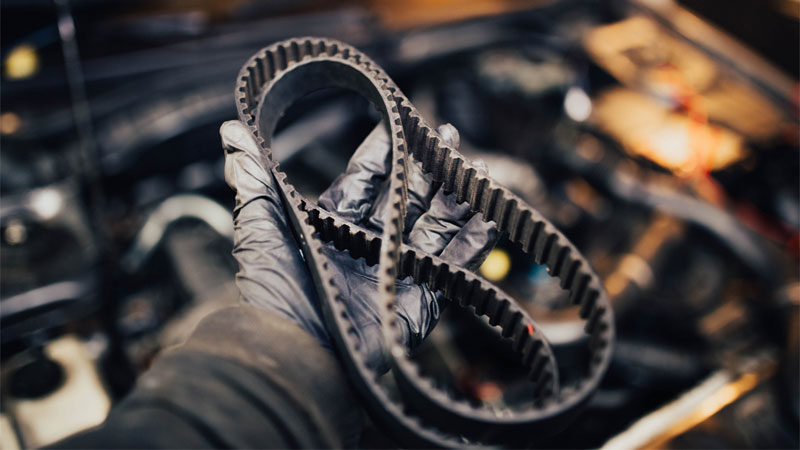A destroyed engine will cost you thousands of dollars to replace.
One of the most significant wear items on your car is its timing belt. When this rubber-toothed belt is working properly, your engine is operating as designed, but If your timing belt suddenly breaks your car will stop. Moreover, you might incur engine damage and in a worse case scenario you may need to replace your engine.
It’s crucial that you replace your timing belt within your manufacturers prescribed maintenance intervals and avoid a breakdown and a potentially costly repair job.
About Timing Belts
Also known as a cam belt, a timing belt is tasked with turning the engines camshaft. Essentially, the timing belt keeps your engine in sync by providing timed motion between the camshaft and the crankshaft.
The crankshaft changes piston linear energy into rotational energy that is used to turn the wheels. The camshaft is tasked with opening and closing the engines valves to bring gas and air into the engine and out again.
The timing belt enables two divergent components camshaft and crankshaft to do what they do together. When your belt breaks, your car will stop.
See Also – Bad Camshaft Position Sensor Symptoms
Replacement Intervals
Your manufacturer plainly states in your owners manual the replacement intervals for a timing belt. You may have heard mileage numbers ranging from 60,000 to 100,000 miles. Mechanics may recommend that you change it once every four to six years, even if you have not reached the mileage threshold.
Made of rubber with high-tensile fibers, a timing belt can wear down from use as well as from age. Ultimately, you will want to schedule a timing belt replacement job before your manufacturer says that it is due.
When replacing a timing belt, your mechanic may recommend that you also replace the tensioners and idlers that hold the timing belt in place. If either part is worn or loose, it could cause your replacement timing belt to fail soon after it has been installed.
Thus, a timing system replacement that includes the belt, an idler and a tensioner may be the best approach here.
And while you are at it, you may want to have the water pump replaced while your mechanic is working in the same area. You will pay more for a complete timing system replacement and a water pump change out, but you will save on labor when your pump eventually does fail.
Worn Out Belt? Not Easy To Determine!

Furthermore, many mechanics will also advise changing the water pump at the same time as the timing belt – even if it hasn’t failed – as most of the labor that’s related to replacing a water pump has already been done when changing the timing belt.
This is your decision as a water pump could last as long as your car or it could fail at some point in the future. If the latter takes place, you could be faced with a significant car repair bill in addition to going through all the trouble of being without your car for several days.
Weekend mechanics often feel comfortable enough to replace their car’s timing belt without the assistance of a garage. With a trusty Haynes or Chilton repair manual by your side or possibly with the help of YouTube, you can remove and replace the timing belt (and water pump) in a few hours.
Possible Damage
One area of possible concern for car owners is the type of engine that they have. Yours is either interference or it is free running and the former can cause you much trouble if the timing belt suddenly breaks.
Quite possibly, an open valve could be hit by a piston in motion, damaging your engine internally. If that happens, you will need to be towed to a garage and have your belt replaced.
If your mechanic detects engine damage you are looking at a possible engine replacement, costing you thousands of dollars to fix.
Cost to Replace a Timing Belt
Actual timing belt replacement costs can vary depending on the make and model of your car, as well as your location and the mechanic you choose. On average, you can expect to pay between $500 and $1000 for timing belt replacement (parts and labor).
The timing belt itself usually costs between $25 and $100, but the majority of the cost comes from the labor involved in removing and replacing the belt.
As already mentioned, water pump replacement is usually done at the the same time even if the water pump is completely fine. This all comes back to the amount of time necessary to get to that area of your engine. In most cases, it makes sense to get the water pump swapped out at the same time rather than waiting for it to fail in the future.
Shop Around And Save
You can buy needed automotive parts at a local auto parts store, shop online for parts from a wholesaler, or visit your dealer’s parts department to get what you need. Shop around — the price differential between auto parts retailers can be significant.
References
See Also – Should I Repair or Replace My Car?
- 2024 Mazda CX-50: A Compact SUV with Premium Aspirations - Apr 15, 2024
- 2024 Ford Mustang Review (Iconic Pony Car Evolves) - Apr 4, 2024
- 2024 Ford Maverick Review (Looks Like a Truck, Drives Like a Car) - Mar 28, 2024


